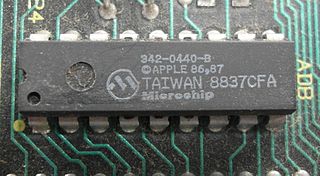
In computing, memory refers to a device that is used to store information for immediate use in a computer or related computer hardware device. It typically refers to semiconductor memory, specifically metal–oxide–semiconductor (MOS) memory, where data is stored within MOS memory cells on a silicon integrated circuit chip. The term "memory" is often synonymous with the term "primary storage". Computer memory operates at a high speed, for example random-access memory (RAM), as a distinction from storage that provides slow-to-access information but offers higher capacities. If needed, contents of the computer memory can be transferred to secondary storage; a very common way of doing this is through a memory management technique called "virtual memory". An archaic synonym for memory is store.

EEPROM (also E2PROM) stands for electrically erasable programmable read-only memory and is a type of non-volatile memory used in computers, integrated in microcontrollers for smart cards and remote keyless systems, and other electronic devices to store relatively small amounts of data but allowing individual bytes to be erased and reprogrammed.

A programmable logic device (PLD) is an electronic component used to build reconfigurable digital circuits. Unlike integrated circuits (IC) which consist of logic gates and have a fixed function, a PLD has an undefined function at the time of manufacture. Before the PLD can be used in a circuit it must be programmed (reconfigured) by using a specialized program.
Atmel Corporation was a designer and manufacturer of semiconductors before being acquired by Microchip Technology in 2016. It was founded in 1984. The company focuses on embedded systems built around microcontrollers. Its products include microcontrollers radio frequency (RF) devices including Wi-Fi, EEPROM, and flash memory devices, symmetric and asymmetric security chips, touch sensors and controllers, and application-specific products. Atmel supplies its devices as standard products, application-specific integrated circuits (ASICs), or application-specific standard product (ASSPs) depending on the requirements of its customers.
Non-volatile random-access memory (NVRAM) is random-access memory that retains data without applied power. This is in contrast to dynamic random-access memory (DRAM) and static random-access memory (SRAM), which both maintain data only for as long as power is applied, or such forms of memory as magnetic tape, which cannot be randomly accessed but which retains data indefinitely without electric power.
Magnetoresistive random-access memory (MRAM) is a type of non-volatile random-access memory which stores data in magnetic domains. Developed in the mid-1980s, proponents have argued that magnetoresistive RAM will eventually surpass competing technologies to become a dominant or even universal memory. Currently, memory technologies in use such as flash RAM and DRAM have practical advantages that have so far kept MRAM in a niche role in the market. MRAM is in production by Everspin Technologies, and other companies, including GlobalFoundries, Avalanche Technology, Sony, and Samsung Electronics, have announced production plans from 2016 onward. A recent, comprehensive review article on magnetoresistance and magnetic random access memories is available as an open access paper in Materials Today.

Cypress Semiconductor Corporation was an American semiconductor design and manufacturing company. It offered NOR flash memories, F-RAM and SRAM Traveo microcontrollers, the industry's only PSoC programmable system-on-chip solutions, analog and PMIC Power Management ICs, CapSense capacitive touch-sensing controllers, Wireless BLE Bluetooth Low-Energy and USB connectivity solutions. In June 2019, Infineon Technologies announced it would acquire Cypress for $9.4 billion. The deal closed in April 2020, making Infineon one of the world's top 10 semiconductor manufacturers.
Non-volatile memory (NVM) or non-volatile storage is a type of computer memory that can retrieve stored information even after having been power cycled. In contrast, volatile memory needs constant power in order to retain data. Examples of non-volatile memory include flash memory, read-only memory (ROM), ferroelectric RAM, most types of magnetic computer storage devices, optical discs, and early computer storage methods such as paper tape and punched cards.
Semiconductor memory is a digital electronic semiconductor device used for digital data storage, such as computer memory. It typically refers to MOS memory, where data is stored within metal–oxide–semiconductor (MOS) memory cells on a silicon integrated circuit memory chip. There are numerous different types using different semiconductor technologies. The two main types of random-access memory (RAM) are static RAM (SRAM), which uses several transistors per memory cell, and Dynamic random-access memory (DRAM), which uses a single transistor and MOS capacitor per cell. Non-volatile memory uses floating-gate memory cells, which consist of a single transistor per cell.

Microchip Technology Inc. is a publicly-listed American corporation that is a manufacturer of microcontroller, mixed-signal, analog and Flash-IP integrated circuits. Its products include microcontrollers, Serial EEPROM devices, Serial SRAM devices, embedded security devices, radio frequency (RF) devices, thermal, power and battery management analog devices, as well as linear, interface and wireless solutions.
SONOS, short for "silicon–oxide–nitride–oxide–silicon", more precisely, "polycrystalline silicon"—"silicon dioxide"—"silicon nitride"—"silicon dioxide"—"silicon", is a cross sectional structure of MOSFET (metal-oxide-semiconductor field-effect transistor), realized by P.C.Y. Chen of Fairchild Camera and Instrument in 1977. This structure is often used for non-volatile memories, such as EEPROM and flash memories. It is sometimes used for TFT LCD displays. It is one of CTF (charge trap flash) variants. It is distinguished from traditional non-volatile memory structures by the use of silicon nitride (Si3N4 or Si9N10) instead of "polysilicon-based FG (floating-gate)" for the charge storage material. A further variant is "SHINOS" ("silicon"—"hi-k"—"nitride"—"oxide"—"silicon"), which is substituted top oxide layer with high-κ material. Another advanced variant is "MONOS" ("metal–oxide–nitride–oxide–silicon"). Companies offering SONOS-based products include Cypress Semiconductor, Macronix, Toshiba, United Microelectronics Corporation and Floadia.
nvSRAM is a type of non-volatile random-access memory (NVRAM). It is similar in operation to static random-access memory (SRAM).
Spansion Inc. was an American-based company that designed, developed, and manufactured flash memory, microcontrollers, mixed-signal and analog products, and system-on-chip (SoC) solutions. The company had more than 3,700 employees in 2014 and is headquartered in Sunnyvale, California. Spansion is a former joint-venture between AMD and Fujitsu. In August 2013, Spansion closed the acquisition of the Microcontroller and Analog Business of Fujitsu Semiconductor Limited.

Read-only memory (ROM) is a type of non-volatile memory used in computers and other electronic devices. Data stored in ROM cannot be electronically modified after the manufacture of the memory device. Read-only memory is useful for storing software that is rarely changed during the life of the system, also known as firmware. Software applications for programmable devices can be distributed as plug-in cartridges containing read-only memory.

Random-access memory is a form of computer memory that can be read and changed in any order, typically used to store working data and machine code. A random-access memory device allows data items to be read or written in almost the same amount of time irrespective of the physical location of data inside the memory. In contrast, with other direct-access data storage media such as hard disks, CD-RWs, DVD-RWs and the older magnetic tapes and drum memory, the time required to read and write data items varies significantly depending on their physical locations on the recording medium, due to mechanical limitations such as media rotation speeds and arm movement.
Thyristor RAM (T-RAM) is a type of random-access memory dating from 2009 invented and developed by T-RAM Semiconductor, which departs from the usual designs of memory cells, combining the strengths of the DRAM and SRAM: high density and high speed. This technology, which exploits the electrical property known as negative differential resistance and is called thin capacitively-coupled thyristor, is used to create memory cells capable of very high packing densities. Due to this, the memory is highly scalable, and already has a storage density that is several times higher than found in conventional six-transistor SRAM memory. It was expected that the next generation of T-RAM memory will have the same density as DRAM.

Virage Logic corporation, founded 1996, was an American provider of both functional and physical semiconductor intellectual property (IP) for the design of complex integrated circuits. The company's differentiated product portfolio included processor centric solutions, interface IP solutions, embedded SRAMs and NVMs, embedded memory test and repair, logic libraries, and memory development software.

Integrated Device Technology, Inc. is an American corporation headquartered in San Jose, California, that designs, manufactures, and markets low-power, high-performance mixed-signal semiconductor solutions for the advanced communications, computing, and consumer industries. The company markets its products primarily to original equipment manufacturers (OEMs). Founded in 1980, the company began as a provider of complementary metal-oxide semiconductors (CMOS) for the communications business segment and computing business segments. The company is focused on three major areas: communications infrastructure, high-performance computing, and advanced power management.
Everspin Technologies is a public semiconductor company headquartered in Chandler, Arizona, United States. It develops and manufactures discrete magnetoresistive RAM or magnetoresistive random-access memory (MRAM) products, including Toggle MRAM and Spin-Transfer Torque MRAM (STT-MRAM) product families. It also licenses its technology for use in embedded MRAM (eMRAM) applications, magnetic sensor applications as well as performs backend foundry services for eMRAM.

The memory cell is the fundamental building block of computer memory. The memory cell is an electronic circuit that stores one bit of binary information and it must be set to store a logic 1 and reset to store a logic 0. Its value is maintained/stored until it is changed by the set/reset process. The value in the memory cell can be accessed by reading it.









